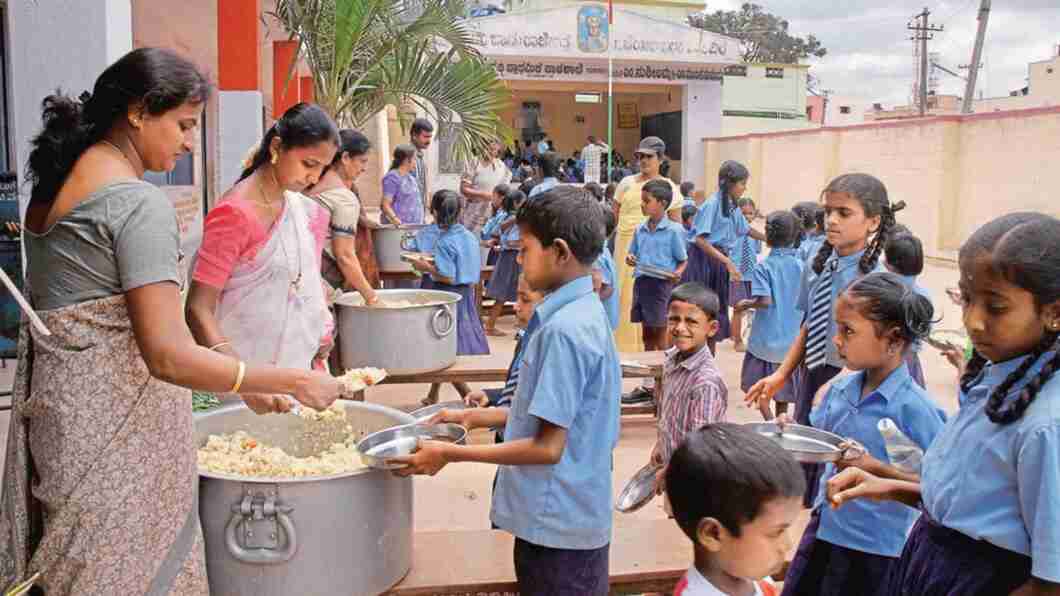7 Crore+ Customers

Affordable Premium

7 Crore+ Customers

Affordable Premium



On 15th August 1995, Midday Meal Scheme was launched in India for children under the name of ‘National Programme of Nutritional Support to Primary Education’ (NP-NSPE). Recently (September 2021), the Government renamed this scheme to Pradhan Mantri Poshan Shakti Nirman or ‘PM POSHAN’. Each alteration in name brings some changes in the scheme.
The Midday Meal Scheme has been implemented in the Union Territory of Puducherry under the French Administration since 1930. In post-independent India, the Midday Meal Scheme was first launched in Tamil Nadu, pioneered by the former Chief Minister K. Kamaraj in the early 1960s. Stay tuned to learn about these changes and everything about the Midday Meal Scheme in India.


The Midday Meal Scheme in India offers complimentary meals to pupils enrolled in basic schools. It seeks to increase student attendance, lessen hunger in the classroom, and enhance general health and nutrition. The program provides kids with hot, wholesome meals throughout the school day.
This important project, backed by the Indian government, intends to give schoolchildren nutritious meals, improving their nutritional intake and their access to high-quality education. Since its launch, the program has significantly enhanced millions of children's health and nutrition while increasing school attendance.
The Midday Meal Scheme in India was launched on August 15, 1995. It was then known as the National Programme of Nutritional Support to Primary Education. The Ministry of Human Resources and Development (MHRD) is the authority to carry out the program.
The ministry in charge of the program, the Ministry of Education, renamed it the PM-POSHAN (Pradhan Mantri Poshan Shakti Nirman) Scheme in September 2021. Additionally, the Central Government declared that by 2022, 24 lakh more pre-primary pupils attending government and government-aided institutions would be covered by the program.
There are cooked meals with set nutritional values for children aged 6 to 14. Every child enrolling in local body schools, government-aided schools, special training centres (STC), and government schools can receive this lunch.
With 6753947 children from classes I–V of 67739 Primary schools and 4137265 students from classes VI-VIII of 16195 Upper Primary schools, the program has covered 100% of government-run, government-aided schools and EGS/AIE facilities.
Children enrolled in government and government-aided schools would receive prepared meals as part of the programme, which the Supreme Court of India mandated in 2001. The following are the main purposes of the midday meal scheme:
Enhancing the dietary condition of kids attending government, government-aided Education Guarantee Scheme (EGS), Alternative and Innovative Education (AIE), and locally sponsored schools.
Encouraging students from low-income families to attend school consistently and supporting their concentration during class.
Supplying summertime dietary help to primary school students in drought-affected areas.
Two important Sustainable Development Goals (SDGs) are directly aligned with the program: SDG 4 Quality Education and SDG 2 Zero Hunger.
Under the Midday Meal (MDM) Scheme, children get one meal of the day. Here, children need to be enrolled in government schools, local body schools, special training centres, maktabs, madrasas and government-aided schools that are supported under the Sarva Shiksha Abhiyan.
Under the Midday Meal Scheme in India, around 11.80 crore children (in 11.20 lakh government and government-aided schools) will get hot cooked food.
However, under the new scheme ‘PM POSHAN’, 24 lakhs of children studying in pre-primary schools who are already covered under the Integrated Child Development Services will get food under the MDM scheme.
The PM Poshan will be operational initially for 5 years (2021-22 to 2025-26). Here, the Central Government will take responsibility for ₹ 54,061 crores of the total approximate expenditure of ₹ 1.3 lakh crore. On the other hand, the State Governments will pay ₹ 31,733 crores.
Note: The Central Government will release ₹ 45,000 crores as subsidies for food grains.
From the above discussion, individuals can learn about the Midday Meal Scheme. However, to receive benefits offered under this scheme, children must fulfil certain eligibility criteria.
Children will receive food under the Midday Meal Scheme if they study in Primary (Class I-V) and Upper Primary Classes (Class VI-VIII) in any of the following schools:
With the following goals in mind, the National Programme of Midday Meals in Schools was launched:
The MDMS is regarded as the world's biggest school feeding program. Here are the baic features of the scheme:
Every kid enrolled in this program will get a midday meal containing 450 calories and 12 grams of protein at the primary level and 700 calories and 20 grams at the upper primary level.
The Midday Meal Program is funded centrally. The central government and the corresponding state governments split the costs associated with putting the system into action.
All states receive free food grains from the federal government.
The federal government and the corresponding state governments split the costs associated with infrastructure construction, food grain transportation, cooking, and paying cooks and assistants.
The states' contributions differ based on necessity. The Ministry of Education oversees and implements it.
Schools buy high-quality AGMARK products for their lunchtime lunches. Meals have to be provided on school property.
Cooking facilities in schools must be sanitary.
MDMS is observed by School Management Committees (SMCs).
Headmasters are required to reimburse the MDM fund to use school cash for meals.
The State FDA may inspect the quality of food. If there are no cooked meals available, a food allowance is given:
Child's allotted amount of dietary grains.
Cost of cooking for the state.
The implementation process has many methods and branches. Here are the implementation methods of the world’s biggest school feeding program:
The central and state governments jointly implement the Midday Meal Program.
The state governments receive guidance from the federal government on how to carry out the program.
Certain states follow regulations that are different from the Central Guidelines.
There is now a National Steering-Current-Monitoring Committee (NSMC). This keeps an eye on the software. It offers suggestions for the federal and state governments' policies.
The initiative is also overseen by steering and monitoring committees at the state level. The Programme Approval Board releases Central aid.
Subsidies are given upon submission of the committee's annual work plan.
Program management power has been delegated to a nodal department. This division organises implementation cells. To guarantee efficient execution, one officer is tasked with overseeing each district and block.
Panchayats/Urban Local Bodies handle program management in states where basic education is under their purview.
Following is a list of benefits of Midday Meal Scheme:
Education should never be hampered by hunger. Children must have access to food and education without having to decide between the two. Now that individuals/parents know about the Midday Meal Scheme in India, they can ensure their children get at least a one-time meal at school and the benefits of education.
You may also like to read: